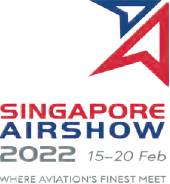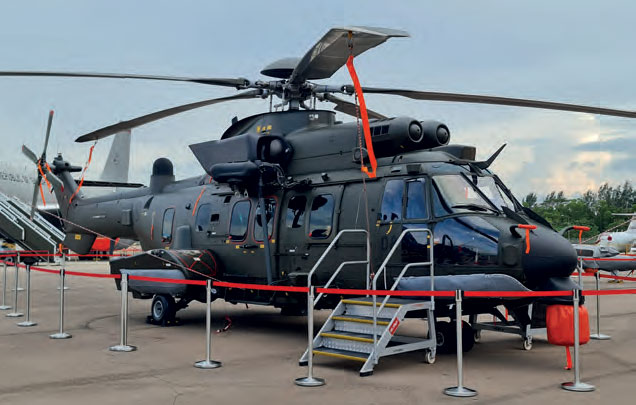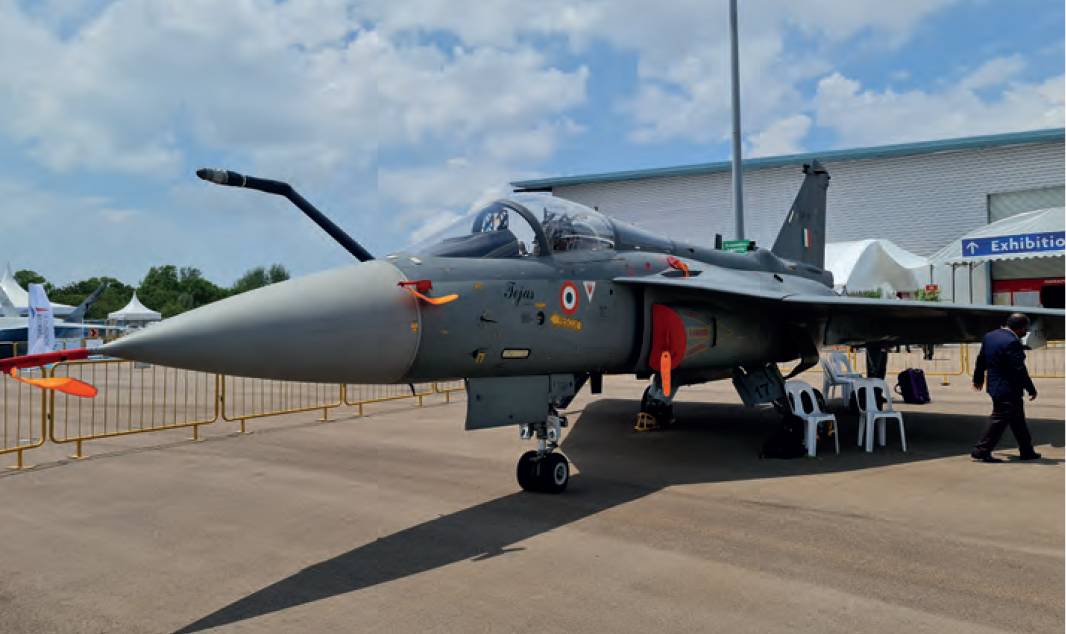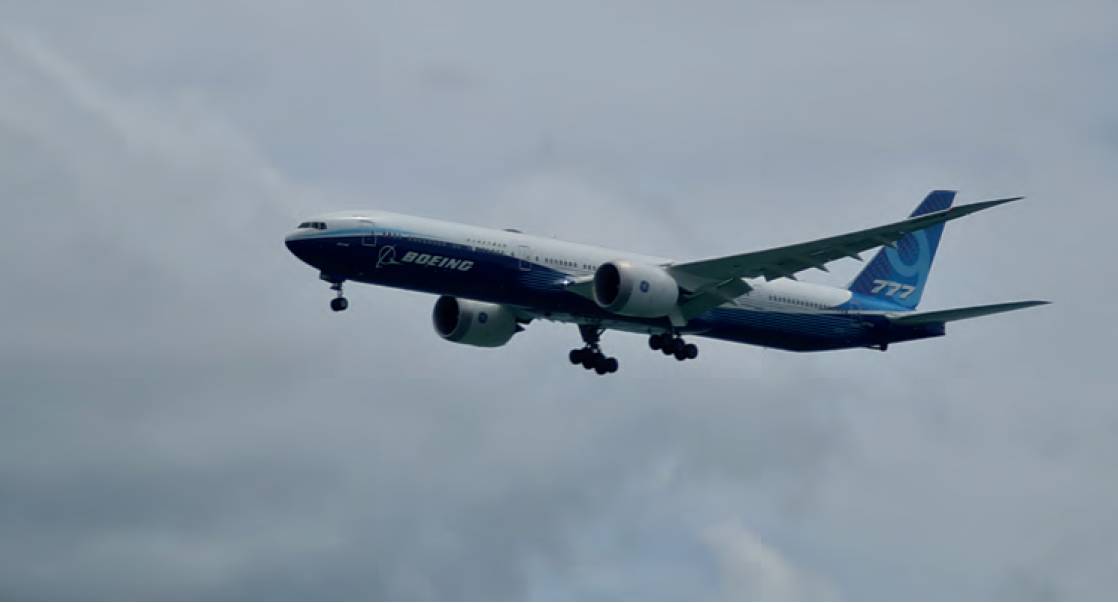SHOW REPORT Singapore Airshow 2022
Taking flight from difficult times in Singapore
JR NG reports from the Singapore Airshow 2022 which marks Southeast Asia’s return to large-scale aerospace and defence exhibitions.
 China’s AVIC returned to Singapore with a booth.
China’s AVIC returned to Singapore with a booth.
Two years after the onset of the Covid-19 pandemic that restricted visitors from China and prompted eleventh-hour cancellations from major international exhibitors at the previous edition of the Singapore Airshow, the city-state once again staged the event from 15-18 February amid strict health safety protocols that limited participation to trade visitors and invited guests.
 While there were only reported 39 cumulative confirmed infections around the same period two years ago before Singapore entered a full lockdown to stem the tide, it nevertheless posted a daily total of 19,420 local and imported cases on the opening day of the 2022 airshow.
While there were only reported 39 cumulative confirmed infections around the same period two years ago before Singapore entered a full lockdown to stem the tide, it nevertheless posted a daily total of 19,420 local and imported cases on the opening day of the 2022 airshow.
As such, only 13,000 pre-registered persons could attend the event, a sharp decline from the 30,000 participants in 2020 and 54,000 in 2018. Participating companies also took a massive hit, with under 600 exhibitors, compared with the 930 and more than 1,080 in 2020 and 2018, respectively.
The Republic of Singapore Air Force (RSAF) displayed its latest Airbus Helicopters H225M medium-lift helicopter to the public for the first time.
The type has been extensively customised for Singaporean requirements and will progressively replace the service’s ageing AS330M Super Puma platforms which entered service in the early 1980s and are facing obsolescence.
 Airbus Helicopters’ H225M medium-lift helicopter making its debut
Airbus Helicopters’ H225M medium-lift helicopter making its debut
The H225M helicopter showcased at the RSAF’s static display area was seen fitted with an integrated electronic warfare suite, an L3 Harris Wescam MX-15 electro-optical turret, a tail-boom satellite communications dome and Trakka Systems TrakkaBeam A800 high-intensity searchlight that is compatible with night-vision systems.
The service also earlier highlighted how the new helicopters had been designed around highly digitalised avionics and crew systems, including a glass cockpit and Thales Scorpion helmet-mounted displays.
The RSAF is in the midst of operationalising the new helicopters for a range of missions, including humanitarian assistance and disaster relief, search and rescue, and tactical airlift.
Singapore is also acquiring Boeing CH-47F Chinook heavy-lift helicopters to replace its ageing CH-47SD platforms. The first example had already been delivered to the service’s training detachment in Australia by May 2021.
Meanwhile, RSAF chief Major General Kelvin Khong told the media that initial deliveries of the service’s upgraded Lockheed Martin F-16 combat aircraft had already commenced from June 2021. New capabilities include an active electronically scanned array (AESA) radar for extended detection range and improved tracking and targeting, datalinks, cockpit displays and all-weather ground-attack ability.
MG Khong also noted that the upgraded F-16 fleet will serve for at least another decade, even as delivery of its first short take-off and vertical landing Lockheed Martin F-35B Lightning II combat aircraft remains on track for a 2026 delivery. In 2019, Singapore announced the acquisition of four F-35Bs for initial evaluation and training in the US.
Aerospace and defence prime Aviation Industry Corporation of China (AVIC) made a surprise return to the Singapore Airshow despite pervasive Covid protocols that has practically isolated China from the rest of the world. AVIC clearly broadcasted its intent to resume its international marketing activities with its first ‘comprehensive’ exhibition appearance outside of the mainland, comprising an impressive 210m² booth that covered its portfolio of military trainer and combat aircraft, commercial aircraft, helicopters and uncrewed aerial vehicles (UAVs).
These included the export-oriented Chengdu/ Pakistan Aeronautical Complex JF-17 single-seat and JF-17B twin-seat fighters, the Hongdu L-15 and Guizhou FTC-2000G advanced trainer/ light attack aircraft, the Changhe Z-9WE, Z-10ME attack and Z-19E reconnaissance helicopters. The company also highlighted its Wing Loong family of armed reconnaissance UAVs and MA 700 regional passenger aircraft.
“The Singapore Airshow is the first large-scale comprehensive exhibition of its kind this year and our participation is in line with our practice of internationalisation and seeking win-win solutions for our partners,” an AVIC representative said. “Our commitment to the international market is unwavering despite ongoing uncertainties caused by the global pandemic.”
Besides China, other Asia Pacific countries are also lining up affordable multirole combat aircraft offerings to meet emerging regional demand. Supported by the Indian Air Force (IAF), Hindustan Aeronautics Limited (HAL) highlighted its Tejas Light Combat Aircraft (LCA) with a solo aerobatic demonstration, as well as a static display for the first time.
 Hindustan Aeronautics Limited (HAL) showed off its Tejas Light Combat Aircraft.
Hindustan Aeronautics Limited (HAL) showed off its Tejas Light Combat Aircraft.The Tejas LCA is being offered for the Royal Malaysian Air Force (RMAF)’s Light Combat Aircraft/Fighter Lead-In-Trainer (LCA/FLIT) programme, announced in June 2021, which calls for a total of 18 new-build aircraft to replace the service’s fleet of Aermacchi MB-339CM jet trainers that are already grounded, as well as its BAE Systems Hawk Mk 108 twin-seat and Mk 208 single-seat light attack aircraft.
Turkey (or Türkiye as it would now like to be known) also underlined its intent to expand its Asia-Pacific footprint, showcasing a full-scale mock-up of the Turkish Aerospace Industries (TAI) TF-X for the first time in the region following its debut at the Paris Airshow in 2019.
TAI also took the opportunity to highlight its participation in the Malaysia LCA/FLIT programme with its Hürjet advanced trainer and light attack aircraft, with an eye on expanding co-operation with the Southeast Asian country on ‘new-generation’ technologies, particularly in both aviation and defence.
Ankara had earlier offered Kuala Lumpur potential development and production work on the TF-X fighter programme and the Hürjet, which was boosted by the setting up of a new engineering and design office the western Selangor state in November 2021 – TAI’s first one in the region – as well as an agreement a month later with the University of Kuala Lumpur Malaysian Institute of Aviation Technology for technical training and teaching.
Freighter traffic in the Asia Pacific region continues to grow on the back of e-commerce demands, with Airbus forecasting that regional traffic will increase at an annual rate of 3.6%, well above the global average of 3.1%, and will lead to a doubling in air freight in the region by 2040. The expanding traffic also drives up demand for new-build and converted freighters
Singapore Airlines (SIA), for instance, confirmed an order on 16 February for seven Airbus A350F freighter aircraft with options for five more, which will enable the carrier to phase out its Boeing 747-400F aircraft from the fourth quarter of 2025. Airbus claims that the new aircraft will offer a 40% reduction in fuel consumption and emissions compared to SIA’s existing freighters while providing an increased range. Etihad Airways also signed a letter of intent to procure seven A350F freighters on the same day.
 A full-scale mock-up of the Turkish Aerospace Industries’ (TAI) TF-X
A full-scale mock-up of the Turkish Aerospace Industries’ (TAI) TF-X
Meanwhile, Airbus and Singapore’s ST Engineering joint venture Elbe Flugzeugwerke is riding on the crest of a wave of passenger-to-freighter (P2F) conversion work with the latest order to convert six Airbus A321 aircraft into freighters for European charter and cargo operator SmartLynx Airlines. Work will be at ST Engineering’s conversion sites in Singapore and China through 2023, with all six A321P2F aircraft to be operated by SmartLynx in Europe.
Speaking to media ahead of the airshow on 13 February, an ST Engineering official also pointed to the growing demand for freighter aircraft as e-commerce and air cargo volumes expand worldwide and noted how the company has set up a joint venture called Juniper Aviation Investments to further invest in global P2F opportunities, with the aim of building a portfolio worth US$600m by 2026.
“We are working with industry to increase the rate of recycling and reusing existing aircraft,” said the official. “Apart from contributing to a more sustainable aircraft end-of-life process, recycling and reusing aircraft also provide operators economical alternatives to brand new components and parts.”
In the uncrewed aircraft domain, Israeli companies Elbit Systems and Steadicopter debuted their new fixed and rotary-wing uncrewed aerial vehicles (UAVs), powered by hybrid-electric propulsion systems.
Elbit Systems’ Skylark 3 Hybrid Small Tactical Uncrewed Aerial Systems (STUAS) offers triple the endurance of conventionally-powered models of the Skylark family with up to 18hr of flight operation and a 120km range while retaining the same compact size and weight, a move which the company says significantly enhances mission effectiveness and cost-efficiency.
The company said the Skylark 3 Hybrid will use its internal combustion engine to transit rapidly to an area of operations at altitudes of up to 12,000ft, before engaging its electric motor to loiter over the area. Either method of propulsion is also able to serve as a backup to ensure reliability and safety.
 Elbit Systems’ Skylark 3 Hybrid Small Tactical Uncrewed Aerial Systems (STUAS);
Elbit Systems’ Skylark 3 Hybrid Small Tactical Uncrewed Aerial Systems (STUAS);
Meanwhile, Steadicopter revealed its hybrid Black Eagle 50H vertical take-off and landing (VTOL) UAV, which combines the capabilities of its gasoline-powered Black Eagle 50 and electric Black Eagle 50E platforms with up to five hours of operation with a 12kg payload by exploiting its two methods of propulsion.
Commercial use of uncrewed aircraft for ship-to-shore logistics is set to take off following the forming of a consortium between ST Engineering, Sumitomo Corporation and Skyports. ST Engineering announced on 13 February that the consortium will engage key customers for UAV-based parcel deliveries, with the aim of establishing a delivery network capable of facilitating transfers of urgently required items weighing up to 7kg.
The static display was another casualty of the diminished international presence, with the normally packed international aircraft display area showing plenty of bare tarmac with a total of just 17 aircraft and full-scale mock-ups following the unexplained no-show of the eagerly-anticipated Royal Malaysian Air Force Sukhoi Su-30MKM fighter.
However, the lack of variety was somewhat salvaged by the show debut of several aircraft types, such as the IAF’s Tejas LCA, the US Air Force’s Boeing KC-46A Pegasus aerial tanker and conventional take-off and landing (STOVL) F-35A Lightning II aircraft (author’s note: previously it has always been the USMC’s F-35B on static display), and the RSAF’s H225M helicopter.
Airbus clearly emerged the winner of this reduced static display line-up, with its aircraft – the A350-900, A330neo, and A220-300 passenger aircraft, A400M Atlas airlifter, A330 Multi Role Tanker Transport (MRTT) and H225M helicopter – taking up the lion’s share of the occupied space.
The aerial display was, likewise, a muted affair in stark contrast with previous events, especially after the controversial inclusion of the Chinese air force’s First August flight demonstration team in the 2020 airshow. With the airshow closed to the public, organisers live-streamed the daily displays for viewers to watch at home.
For the latest edition, the RSAF deployed one of its F-16C aircraft on a solo aerobatic display and a two-ship AH-64D Apache attack helicopter formation, while a Japan-based US Marine Corps F-35B once again impressed the locals with its gravity-defying STOVL tricks. The only military aerobatic act was the Indonesian Air Force Jupiter Aerobatics Team, flying a six-ship formation of the KAI KT-1 Woongbi turboprop. Helping to somewhat fill the flight display gap was the first-time solo displays of the Airbus A350-1000 and Boeing 7779 passenger jets, as well as the IAF’s Tejas LCA.
 Flypast by Boeing 777X. (All images provided by JR Ng)
Flypast by Boeing 777X. (All images provided by JR Ng)
With the Asia-Pacific aviation industry’s slow recovery from the Covid-19 pandemic, Singapore Airshow 2022 has been seen as a key milestone in the region’s ongoing struggle to return to pre-pandemic levels of activity and growth.
The event also took place amid what has been perceived as a ‘high level’ of optimism with increasing passenger travel and gradual easing of travel restrictions, with some top officials suggesting that ‘the worst may be over’ as the industry bounces back. Singapore-based companies, for example, are planning to hire more than 1,000 people over the next two years.
The successful conclusion of the airshow under strict health safety protocols also demonstrated to other regional countries that it is still possible to hold large-scale events amid less-than-ideal situations, with requirements like daily rapid antigen testing and enforced social distancing appearing to be successful at keeping participants safe, despite large numbers of daily reported infections within the host country.